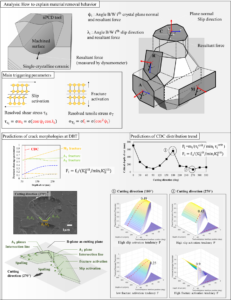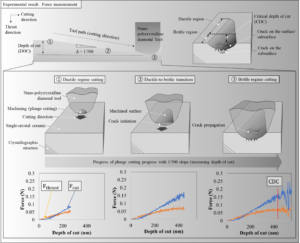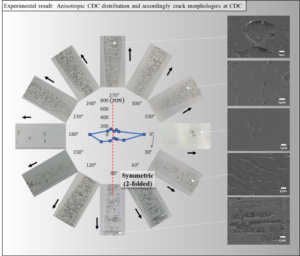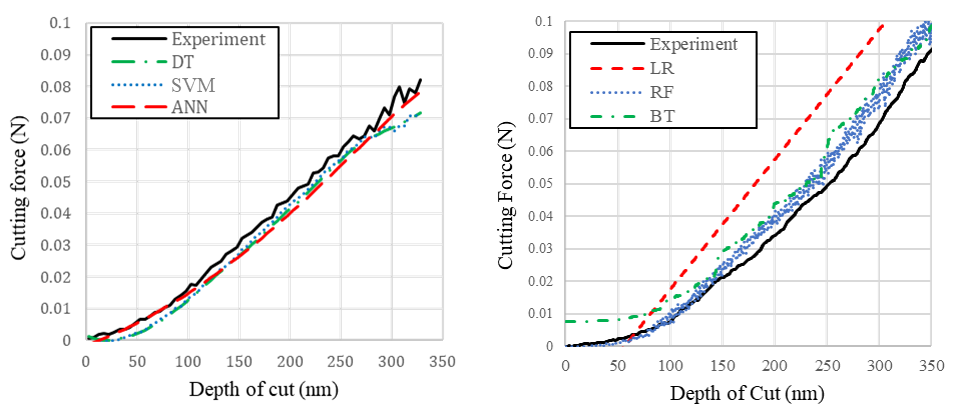Precision Beyond Imagination
Unlike conventional machining, ultra-precision machining can handle difficult-to-cut and emerging materials with incredible tolerances and surface quality. It opens new opportunities to various industries by allowing full 3-D feature generation with less than 100s of nanometer form accuracy and single/sub-nanometer surface quality. Feasibility of unrealistic machining quality removes typical machining challenges, which leads to a new manufacturing paradigm called MFD (Manufacturing for Design).
This is an accordion element with a series of buttons that open and close related content panels.
Ultra-Precision Machining of Single Crystal Sapphire

Research team: Suk Bum Kwon, Aditya Nagaraj
Single crystalline sapphire (Al2O3) is a ceramic material commonly used in various advanced engineering applications due to its excellent mechanical, chemical, and thermal properties. Sapphire is commonly used as the base material for precision products, such as precision lenses, electronic substrates and laser diodes which require an ultrafine surface with extremely small tolerances. Due to the pronounced brittleness and hardness exhibited by sapphire, there are many difficulties encountered during processing. Ultra-precision machining (UPM) has been suggested as one way to precisely process sapphire. By using ultra-precision machining with the depth of cut of a few nanometers, an extremely fine machined surface can be obtained. At this scale, sapphire transitions from a brittle material response and exhibits plastic deformation and ductile material removal. This phenomenon is called the ductile-brittle transition and it shows an anisotropic trend due to the hexagonal symmetry of the sapphire unit cell. The ductile-brittle transition phenomenon, which occurs during UPM is still under a veil because the exact mechanisms are not yet fully understood. This research aims to discover and visualize the mechanism of ductile-brittle transition during the UPM of single-crystal sapphire based on the slip and fracture system activation hypothesis. Further, this hypothesis will be used to predict the crack morphology and critical depth of cut where the ductile-brittle transition begins in terms of cutting direction and depth of cut. Orthogonal ultra-precision machining was conducted on all distinctive crystal planes of ceramics, and data on critical depth of cut (CDC) where DBT occurs, and corresponding crack morphologies were obtained.




Prediction of Cutting and Thrust Force Using Soft Computing

Research team: Suk Bum Kwon, Aditya Nagaraj, Sangjin Maeng
Research on predicting the ductile-brittle transition in sapphire and other ceramics during ultra-precision machining have identified various triggering parameters responsible for ductile plastic shear or brittle fracture. The material response and evolution of plastic deformation or fracture is dependent on the resultant force and it’s projection on the crystal lattice of the ceramic. However, the relationship between the machining conditions and these triggering parameters is typically nonlinear, dynamic, and multi-scale in time and space. Further, many variables such as tool wear, existing defects in the workpiece and variations in the machining environment add a stochastic aspect to the force magnitude which make the prediction using analytical or empirical models difficult. In such circumstances, data science approaches have been used successfully to accurately model, predict and control complex systems. This research aims to use machine learning models to predict the cutting and thrust forces for a given set of input parameters. Different algorithms were tested to predict the cutting and thrust forces in the case of sapphire and these will be expanded to cover other ceramic materials.
Anisotropy of Residual Stresses and Subsurface Damage

Research team: Aditya Nagaraj, Suk Bum Kwon, in collaboration with Prof. Woo Kyun Kim @ University of Cincinnati (UC)
Apart from the challenges mentioned in regard to processing ceramics, machining leads to surface damage in the form of cracks, residual stresses and subsurface damage which can cause failure of the ceramic components at premature loads and the theory governing residual stresses and subsurface damage is poorly understood. Residual stresses are those stresses that remain after an applied load is removed and can be caused due to plastic deformation, temperature gradients or phase transformation, all of which can occur during machining of ceramics. Residual stresses can be either compressive or tensile and require expensive post processing steps such as annealing or polishing to minimize. This research aims to understand the anisotropy in residual stresses and subsurface damage during ultra-precision machining of ceramics based on crystal symmetry and machining parameters. Experimental results will be used in conjunction with molecular dynamics simulations from our collaborators at UC to develop a comprehensive model of residual stresses and subsurface damage during ultra-precision machining of ceramics. Preliminary results on residual stress measurements have been conducted using confocal Raman Spectroscopy in a joint project with Dr. Justin Morrow at Thermo Fischer Scientific which show a variation in residual stress magnitude based on cutting direction on R-plane of sapphire. Further research will be carried out varying process parameters and ceramic type. The results from this study will be used to devise machining strategies that minimize residual stresses and subsurface damage.
Error Identification

Research team: Sangjin Maeng, Qidi Chen
Geometric errors on the axis and induced by tool setting are inevitable on machine tools. The error degrades the form accuracy of machined parts. Especially, the error on an ultra-precision machine tool,which has machining accuracy under one μm, generates “relatively” worse machining quality than conventional machining tools. To improve the accuracy of machining, error sources have to be analyzed and compensated. The aim of the study is to identify geometric errors of the ultra-precision machine tool.